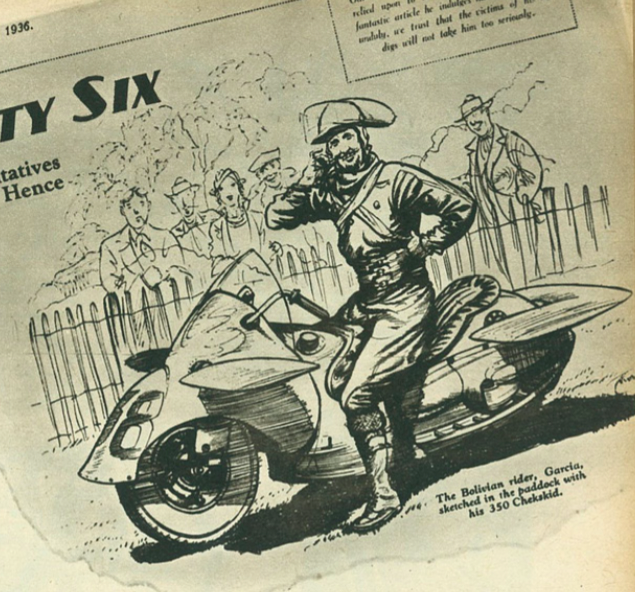HOW’S THIS FOR a prediction from 80 years ago? Winglets on a racing motorcycle. Believe it or not, this illustration was published in Britain’s Motor Cycling on 17 June 1936.
The context was ‘The TT of 1956 Imagined’ and the magazine reproduced the piece in its 7 June 1956 issue, to let readers judge its crystal- ball gazing.
Even 20 years on, some of it was plainly over the top, and the writer could not have anticipated world events and grand prix rule changes between 1936 and ’56.
The text on winglets reads: “Perhaps the most interesting development is the aerodynamic ‘Cherskid’ device fitted to Bolivian rider Garcia’s machine. This, of course, is merely an adaption of well-known principles and consists of four lateral fins, a pair over each wheel, which are automatically elevated or depressed to increase or decrease the reaction between tyre and road surface. The activating mechanism is brought into action as soon as the pressure on the tread of either tyre is lessened and the device is adjusted to give the maximum road-holding under all conditions of braking and acceleration.” Active winglets if you please.
The story makes wild predictions on the development of the Isle of Man course, with a lap record of 200mph, the narrowest part of the road at Glen Helen being 150ft and a race distance 21 laps or 792 miles. In 1956 the Senior TT race distance was seven laps and the lap record belonged to Geoff Duke (Gilera 500-4) from 1955 at 99.97mph.
Duke was a spectator at the 1956 TT, after being suspended for six months for supporting the strike action by private entrants at the 1955 Dutch TT. You did read that correctly – Duke was the number one rider in the world and the suspension was deliberately timed so he would miss the 1956 IoM and Dutch TTs. Australia’s Bob Brown and Keith Campbell were among a total of 13 riders suspended.
Forced induction was permitted in GP racing before World War 2, with supercharged four- and two- stroke machines winning races. The 1936 story speculates on Turbo-Nortons exceeding 245hp (183kW ) at 10,000rpm. That’s close to the output of modern-day MotoGP machines.
“Rudge, New Imperial, Excelsior and Velocette are still pinning their faith to multi-cylinder radial engines,” the article adds. “The other machines are all fitted with oil-cooled two-stroke engines and carry a pair of superchargers, one blower for the scavenging air blast and the other for fuel feed.”
It seems very odd that that not one European manufacturer was mentioned. BMW, DKW, Gilera and Moto Guzzi were racing in 1936, and all four entered works machines in the 1956 IoM TT.
Another engine envisaged was the Gyromoto, with heavy flywheels that would be spun to 30,000rpm over several weeks before the race.
Interestingly, the story predicts a new premier-class capacity limit of 350cc rather than the traditional 500. Reducing capacity was floated as a way of reducing speeds in the 1920s and again in the 1990s, before it actually happened in 2007 with the 800 class.
One prediction for 1956 still hasn’t happened in 2016. “An interesting fact about this year’s meeting is that it is the first TT run without a solitary representative of the old-style poppet-valve engine.”
It then talks of the poppet- valve life being prolonged when Velocette chemists produced Willisidium, the lightest metal known. This was meant as a compliment to Velocette designer Harold Willis. The writer was not to know that Willis would die from meningitis during TT Week in 1939.
It also suggests, looking forward to 1956, that “Norton backed the 1950 Mount Everest expedition to secure supplies of Z-metal for use in turbine blades.”
The world’s tallest mountain was conquered on 29 May 1953 and famed Norton race director Joe Craig died, not long after retiring, in a car accident in Italy on 4 March 1957.
DON COX
